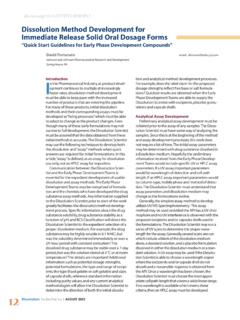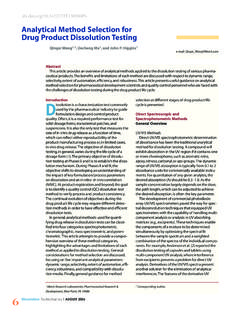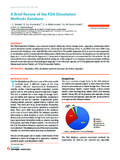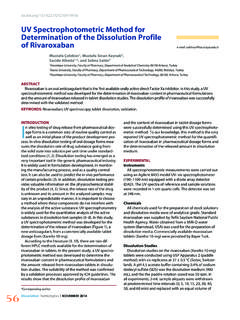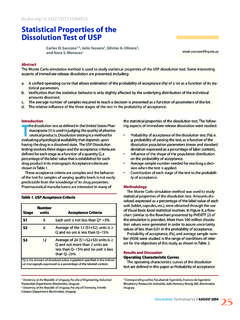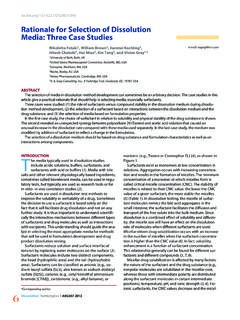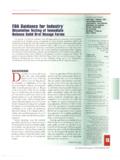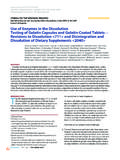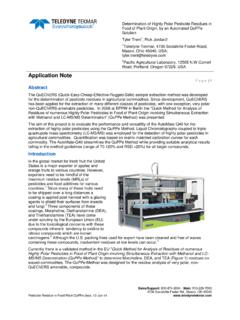Transcription of New Innovations in Testing Sustained-Release …
1 Dissolution Technologies | FEBRUARY 201513 New Innovations in Testing Sustained-Release tablets using an Automated Dissolution System with Online DilutionHuang Hai-wei1, Yuan Song1, Yu Li-ju1, He Lan1, Zhang Qi-ming1, Ning Bao-ming1,*, Keith Wilkinson2, Wei Shi2, and Shi Li-fang21 National Institutes for Food and Drug control, Beijing, China2 Automated Lab Systems, Berkshire, UKABSTRACTThis paper describes the development and validation of an automated method for the dissolution Testing of metformin hydrochloride for use in the quality assurance program. Automation could provide significant improvements in the consistency of results compared with existing manual methods.
2 Care and consideration were given to the automation of preparation of samples and standards in line with current manual procedures. Reproducibility and sample preparation accuracy were quantified, and results obtained were compared against tests performed system was validated in accordance with the Chinese (1), European (2), and United States pharmacopeias (3) using salicylic acid. Salicylic acid Testing for bath calibration also required dilution, which provided a direct comparison to the automated system used to test metformin hydrochloride : Dissolution; automation; online; validation; method hydrochloride is an oral antidiabetic drug used in the treatment of type 2 diabetes.
3 It is also used in the treatment of polycystic ovary syn-drome and has been investigated for other diseases where insulin resistance may be an important factor. Metformin is the only antidiabetic drug that has been conclusively shown to prevent the cardiovascular complications of dia-betes (4, 5). In China, metformin hydrochloride oral solid dosages are manufactured by nearly 200 companies. The current dissolution methodology for Testing metformin hy-drochloride oral solid dosage is to collect samples, replace the sampling volume removed with fresh medium, dilute the sample, and measure by UV spectrophotometry.
4 In China, the National Institute for Food and Drug Control (NIFDC) is responsible for the regulation and quality of drugs. This includes post-market surveillance sampling and speci!cation evaluation of imported drugs as well as drugs that are produced in China. We now report on a novel method for dissolution Testing of solid dose metformin hydrochloride using an automated technique that we believe has advantages over methodology currently used by the DESCRIPTIONA schematic representation of the new method and system con!guration is shown in Figure 1. It consists of the ADT8 dissolution bath from Automated Lab Systems (Berkshire, UK), an ALS 8 Syringe Pump (used for sampling), ALS 3-port Sample Loss Replacement and Sampling Valves, ALS ASP2000 Dual Probe XYZ Robotic Sampler, ALS DXi-50 Syringe Diluter, and PGI T70 Spectrophotometer (PG Instruments, Ltd.)
5 Samples were !ltered using in-line disc !lters (Gelman Acrodisc GF m) con!gured outside the dissolution vessels with Luer !ttings for easy removal and replacement. Metformin hydrochloride exhibits UV absorption linearity up to about 15 mg/L at about 233 nm (7); therefore, 500-mg tablets require approximately 100-fold dilution, which is in line with current methodology (6).The challenge for this test is diluting 1 in 100. The diluter is capable of single dilutions of 1 in 30 within 1% accuracy. Therefore, serial dilution was performed to achieve the higher dilution of 1 in 100. The ASP2000 XYZ Robotic Sampler !
6 Tted with two probes was used. Racks required for the analysis with serial dilution were con!gured using IDIS and ASP2000 teachable rack con!guration, which allowed optimized positioning of samples to suit our requirements. Up to 44 time points, !ve stock standards, eight prepared standards, and two blanks, 100 mL each, can be con!gured for the ASP2000 Dual Probe XYZ Robotic Sampler. This : Schematic of the ASP2000 automated system connected directly to the UV Technologies | FEBRUARY 2015virtual rack design allowed us to con!gure racks to realize the requirements to perform serial dilution. Three racks each accommodating 11 time points (11 # 7), 100-mL blank, and eight standards were con!
7 Gured (Figure 2). The design of two probes realizes simultaneous collection and dilution using three-dimensional XYZ movement to access sample tubes anywhere on the ASP2000 Dual Probe XYZ Robotic Sampler. The left probe, with eight needles, was used to collect all samples simultaneously, while the right probe, with a single needle linked to the diluter, was used to dilute and inject the samples into the spectrophotometer. The commercially available system is used by other companies for streamlining collection, dilution, and measurement for UV or HPLC automation.
8 The schematic in Figure 3 shows the operation work$ow. Prior to sampling, a selected volume of sample is pumped in circulation to the bath to equilibrate fresh sample solution in the lines. At the sampling time interval, the valve switches to the ASP2000 Multiple Probe, which moves to sampling tubes to dispense the desired volume of sample solution. The complete system is controlled by the IDIS software supplied by ALS. This software controls instruments from di%erent manufacturers (baths from Agilent, Distek, Erweka, Pharmatest, Sotax; spectrophotometers from Agilent, Perkin Elmer, Jena, Shimadzu, Thermo; peristaltic and syringe pumps) and allows the user to con!
9 Gure methodologies using instruments from di%erent sources for closed-loop UV analysis, collection, and HPLC analysis linked to ChemStation or Empower as well as to collect, prepare, and measure samples on UV followed by result calculations and reporting. Any combination of bath, pump, and spectrophotometer can be selected. Methodology is created by adding symbols representing the driver for the instruments onto the method desktop; linking the symbols by making connection to points on the symbols; and !nally setting sampling times, temperature, and stirrer speed of the bath. During the analysis, raw data (absorbance in this case) acquired from the spectrophotometer, as well as temperature and stirrer speed from the bath, are stored to IDIS relational database immediately after IDIS software optimizes the timings to make sure the time to the next sampling interval is not compromised.
10 If there is enough time before the next samples are due, the ASP2000 single probe connected to the diluter is positioned at the appropriate tube and sample is aspirated, then the ASP2000 moves to another tube and the diluter dispenses the sample with diluent to perform dilution. If there is not enough time to perform dilution or injection and measurement, the system defers this sequence until after the next collection, a process referred to as Deferred Data Collection by ALS. In practice, this deferment can occur inde!nitely, especially for short time intervals, in which case the processing (dilution, injection, and measurement) will be performed at the end of the dissolution analysis time (Figure 3).
